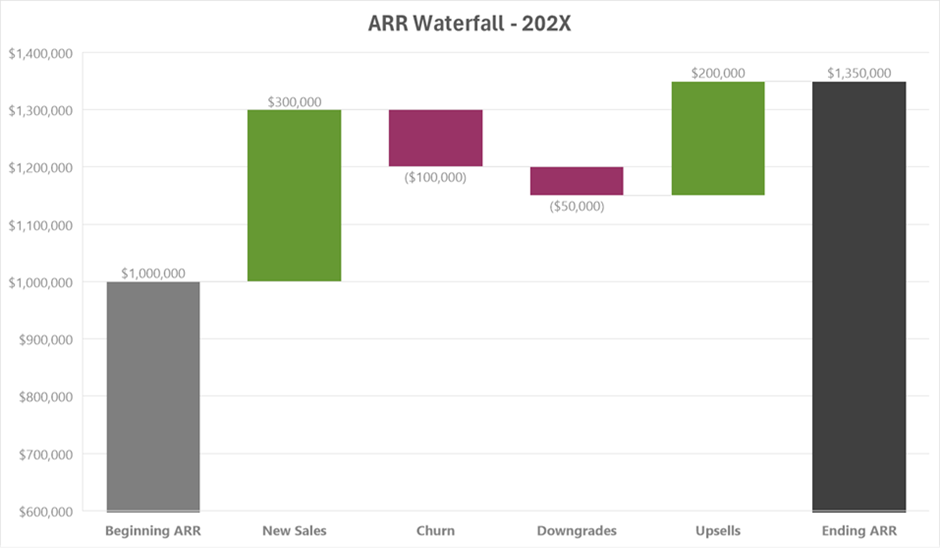The Revenue River
Ever feel like your revenue is flowing — but not always in the right direction? The ARR Waterfall Chart is the tool you need to visualize how your Annual Recurring Revenue (ARR) evolves over time. This chart lets you see where revenue growth and loss occur, providing a clear view of the forces at work in your business model. For SaaS companies, especially those in subscription-based models, this chart is essential for making strategic decisions about growth and customer success.
ARR Waterfall 101 – What It Is and Why It Matters
The ARR Waterfall Chart is a powerful way to visualize revenue over a defined period, capturing expansions, contractions, and everything in between. Rather than just giving you an end number, it reveals how ARR shifts due to factors like new sales, customer churn, downgrades, and upsells. This insight is invaluable for SaaS companies and aligns perfectly with subscription models that focus on long-term customer relationships.
For those considering hiring a fractional CCO or other part-time executive roles, the ARR Waterfall provides a straightforward and actionable way to track recurring revenue and guide customer-focused strategy. At Reditus, we see the ARR Waterfall as a key tool in customer experience strategy and revenue recognition efforts, especially for fractional chief customer roles that manage these functions without the overhead of a full-time team.

Breaking Down the Waterfall – Components Explained (With Examples)
Let’s walk through the components of an ARR Waterfall Chart using the example above:
- Beginning ARR: This is your starting point, the baseline ARR at the beginning of the period. Knowing this gives you a foundation to measure growth, and it’s crucial for understanding how well you’re doing over time.
- New Sales: New sales represent revenue from new customers, showing the effectiveness of your sales efforts in bringing fresh ARR into the business. Tracking this consistently is key to understanding how well your growth strategies resonate with your target market.
- Churn: Churn represents lost ARR due to customers leaving. This is a vital metric because it directly impacts growth potential. At Reditus, we feel it’s important to track churn separately from downgrades. Churn indicates customers who have left entirely, showing where Customer Success may need to step in and improve retention efforts.
- Downgrades: Downgrades show revenue loss when existing customers move to a lower-priced plan. Unlike churn, downgrades reflect customers who are still engaged but may be reducing their spending temporarily. At Reditus, we track churn and downgrades separately because it (1) identifies customers with different intentions — a downgrade may bounce back up as circumstances change, and (2) it incentivizes our Customer Success team to turn potential churn into a downgrade instead, maintaining a relationship that could grow again in the future.
- Upsells: The last of the waterfall metrics, Upsells are a sign of customer satisfaction and engagement, representing additional revenue from existing customers upgrading to higher-value plans. This component is an indicator of a successful customer journey and an enhanced customer experience.
- Ending ARR: After accounting for all growth and losses, you reach the Ending ARR, which reflects your revenue-generating capability for the next period. This final number is what you use to assess overall performance and set new targets.
Why the ARR Waterfall Matters for SaaS Business Models
The ARR Waterfall Chart isn’t just a nice-to-have for SaaS companies; it’s a strategic tool that drives smarter decision-making across the entire business model. Here’s why:
- Aligning Revenue Goals with Customer Service: When you understand ARR changes, you can align customer service efforts more effectively with revenue goals. It enables teams to take proactive steps, such as addressing churn risks early on or promoting upsells to engaged customers.
- Supporting Fractional CCO Decisions: The ARR Waterfall is particularly helpful for fractional executives, like a Fractional Chief Customer Officer, who guide customer strategies on a part-time basis. Using this chart, fractional CCOs make informed decisions about retaining existing customers, encouraging upgrades, and keeping a close eye on revenue fluctuations without the need for a full-time role.
- Adaptable for SaaS Companies: Whether you’re working with a full-time or part-time team, the ARR Waterfall offers a straightforward snapshot of growth vs. losses. It’s especially relevant for subscription models that rely on retaining and expanding customer relationships.
Leveraging the ARR Waterfall for Long-Term Customer Success
Tracking ARR through a waterfall chart goes beyond simply adding or losing revenue; it’s about enhancing the customer experience strategy and creating a sustainable, long-term customer base. Here’s how it supports ongoing success:
- Sustaining Growth: The ARR Waterfall helps SaaS companies build a resilient customer base by providing insights into expansion, contraction, and churned revenue. This allows companies to identify growth opportunities and manage retention more effectively, ultimately supporting revenue generating efforts.
- Spotlight on Customer Journeys: Tracking changes in ARR allows you to see trends in the customer journey — from initial engagement to upgrades or downgrades. This insight can help predict customer needs and proactively manage their experience to reduce churn.
- Revenue Recognition Benefits: The ARR Waterfall Chart also supports revenue recognition, offering accurate insights for forecasting and financial planning. This transparency is crucial for SaaS businesses looking to maintain credibility and make strategic decisions based on reliable data.
Conclusion: ARR Waterfall – A SaaS Essential
The ARR Waterfall Chart is more than just a report; it’s a strategic asset for SaaS companies aiming to understand and optimize their recurring revenue. At Reditus, we believe this tool is vital for tracking revenue changes and ensuring Customer Success is attuned to both growth and potential losses.
By tracking churn and downgrades separately, companies can identify customers with different intentions, empowering Customer Success to manage these relationships proactively. Whether you’re hiring a fractional CCO to help guide customer retention or looking to improve your business model, the ARR Waterfall provides a clear and actionable path forward.